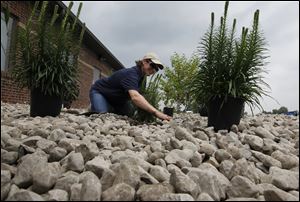
Environmental project takes root in Wauseon
Design filters stormwater runoff
7/8/2013
Cheryl Rice, an urban resource conservationist, installs plants for a rain garden at the Robert Fulton Agriculture Center in Wauseon.
WAUSEON — A half-dozen people recently gathered behind the Robert Fulton Agriculture Center on State Rt. 108 and spent hours working on installing a rain garden.
Rain gardens are bowl-shaped and utilize plants that can survive without being watered.
The garden will filter stormwater runoff to help keep pollutants out of local waterways and also will help provide a natural habitat for local plants.
“With the rain garden, the whole idea is to grab stormwater runoff,” said Cheryl Rice, an urban resource conservationist with the USDA Natural Resources Conservation District and a member of the Toledo-Lucas County Rain Garden Initiative. She said the garden will help take the pressure off the storm system.
The Fulton County commissioners unanimously approved the rain garden in April.
Ms. Rice and Pete Carr, a technician for the Fulton Soil and Water Conservation District, took about three months to plan the garden. Mr. Carr was inspired to start a local project after seeing a rain garden in Defiance.
The garden will be used for practical purposes, but it will also be used to inform the public about rain garden initiatives.
“We all do a lot of education. So this is sort of a great talking point. It’s a great place to have an example and this gives us a great opportunity,” Ms. Rice said.
The USDA Natural Resources Conservation Service also plans to hold workshops and technical tours of the garden.
“Most rain gardens are designed to manage almost all the water from the majority of rainfalls that we get,” Ms. Rice said.
In designing the garden, she decided to include a unique feature not included in every garden. Washed river stone was used as the garden’s base instead of mulch, both to be different and also to accommodate the garden’s office-based location.
Ms. Rice said the washed stone will be helpful because it requires less maintenance than mulch.
Along with creating more rain gardens in the area, Ms. Rice also hopes to educate more residents about starting their own.
One common misconception, she said, is that the gardens are expensive. She said on average, the project could cost between $150 and $300. While sustainability is a big issue, beautifying the environment is also paramount to the project.
“I think it’s gonna look pretty good,” Mr. Carr said. “We have a lot of roof runoff here.”
Contact Kelly McLendon at: kmclendon@theblade.com, 419-724-6522, or on Twitter @KMcBlade.